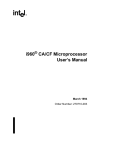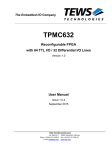Download TPMC630 - TEWS Support Website in Taiwan
Transcript
The Embedded I/O Company TPMC630 Reconfigurable FPGA with 64 TTL I/O / 32 Differential I/O Lines Version 1.0 User Manual Issue 1.6 February 2008 D76630800 TEWS TECHNOLOGIES GmbH Am Bahnhof 7 Phone: +49-(0)4101-4058-0 25469 Halstenbek, Germany Fax: +49-(0)4101-4058-19 www.tews.com e-mail: [email protected] TEWS TECHNOLOGIES LLC 9190 Double Diamond Parkway, Suite 127, Reno, NV 89521, USA www.tews.com Phone: +1 (775) 850 5830 Fax: +1 (775) 201 0347 e-mail: [email protected] TPMC630-10 64 TTL I/O Lines, XC2S300E-6 Spartan-IIE FPGA TPMC630-11 32 Differential I/O Lines, XC2S300E-6 SpartanIIE FPGA TPMC630-12 32 TTL I/O and 16 Differential I/O Lines, XC2S300E-6 Spartan-IIE FPGA This document contains information, which is proprietary to TEWS TECHNOLOGIES GmbH. Any reproduction without written permission is forbidden. TEWS TECHNOLOGIES GmbH has made any effort to ensure that this manual is accurate and complete. However TEWS TECHNOLOGIES GmbH reserves the right to change the product described in this document at any time without notice. TPMC630-20 TEWS TECHNOLOGIES GmbH is not liable for any damage arising out of the application or use of the device described herein. 64 TTL I/O Lines, XC2S600E-6 Spartan-IIE FPGA Style Conventions TPMC630-21 Hexadecimal characters are specified with prefix 0x, i.e. 0x029E (that means hexadecimal value 029E). 32 Differential I/O Lines, XC2S600E-6 SpartanIIE FPGA TPMC630-22 32 TTL I/O and 16 Differential I/O Lines, XC2S600E-6 Spartan-IIE FPGA For signals on hardware products, an ‚Active Low’ is represented by the signal name with # following, i.e. IP_RESET#. Access terms are described as: W Write Only R Read Only R/W Read/Write R/C Read/Clear R/S Read/Set ©2005-2008 by TEWS TECHNOLOGIES GmbH TPMC630 User Manual Issue 1.6 Page 2 of 46 Issue Description Date 1.0 First Issue July 2005 1.1 Technical Specifications added September 2005 1.2 Default Pull Up Voltage changed October 2005 1.3 TTL Transceivers changed March 2006 1.4 Pin out description for each variant May 2006 1.5 New address TEWS LLC September 2006 1.6 New module variants -2x February 2008 TPMC630 User Manual Issue 1.6 Page 3 of 46 Table of Contents 1 2 3 PRODUCT DESCRIPTION ......................................................................................... 8 TECHNICAL SPECIFICATION................................................................................... 9 LOCAL SPACE ADDRESSING................................................................................ 10 3.1 PCI9030 Local Space Configuration ...........................................................................................10 3.2 FPGA Example Design Register Space ......................................................................................10 3.2.1 Output Register 0 (OUT_REG0; 0x00)...............................................................................11 3.2.2 Output Register 1 (OUT_REG1; 0x04)...............................................................................12 3.2.3 Input Register 0 (IN_REG0; 0x08)......................................................................................13 3.2.4 Input Register 1 (IN_REG1; 0x0C) .....................................................................................14 3.2.5 Output Enable Register 0 (OE_REG0; 0x10).....................................................................15 3.2.6 Output Enable Register 1 (OE_REG1; 0x14).....................................................................16 3.2.7 Interrupt Status Register (ISR; 0x18) .................................................................................17 3.2.8 Positive Edge Interrupt Enable Register (PIER; 0x1C) ......................................................17 3.2.9 Negative Edge Interrupt Enable Register (NIER; 0x20) .....................................................18 3.2.10 RAM Address Map Register (RAMR; 0x24) .....................................................................19 3.2.11 RAM Space.......................................................................................................................19 4 PCI9030 TARGET CHIP........................................................................................... 20 4.1 PCI Configuration Registers (PCR) .............................................................................................20 4.1.1 PCI9030 Header .................................................................................................................20 4.1.2 PCI Base Address Initialization ..........................................................................................21 4.2 Local Configuration Register (LCR)............................................................................................22 4.3 Configuration EEPROM ................................................................................................................23 4.4 Local Software Reset....................................................................................................................24 4.5 Local Bus .......................................................................................................................................24 5 FPGA PROGRAMMING HINTS ............................................................................... 25 5.1 FPGA Design .................................................................................................................................25 5.2 FPGA Pin Assignment ..................................................................................................................25 5.2.1 Pin Assignment of Local Bus Data Signals ........................................................................25 5.2.2 Pin Assignment of Local Bus Address Signals...................................................................26 5.2.3 Pin Assignment of Local Bus Control Signals ....................................................................27 5.2.4 Pin Assignment of Clock Signals........................................................................................27 5.2.5 Pin Assignment of FPGA Input Lines .................................................................................28 5.2.6 Pin Assignment of FPGA Output Lines ..............................................................................29 5.2.7 Pin Assignment of FPGA Output Enable Lines ..................................................................30 6 CONFIGURATION HINTS ........................................................................................ 31 6.1 Big / Little Endian..........................................................................................................................31 6.2 Clock Programming ......................................................................................................................33 7 INSTALLATION........................................................................................................ 35 7.1 Pull Up Voltage..............................................................................................................................35 7.2 I/O Interface ...................................................................................................................................35 7.2.1 TTL I/O Interface.................................................................................................................35 7.2.2 Differential I/O Interface......................................................................................................36 7.3 Back I/O Configuration .................................................................................................................37 7.4 FPGA Debug Connector ...............................................................................................................39 8 PIN ASSIGNMENT – I/O CONNECTOR .................................................................. 40 TPMC630 User Manual Issue 1.6 Page 4 of 46 8.1 Front Panel I/O Connector ...........................................................................................................40 8.1.1 Front I/O Assignment TPMC630-x0 ...................................................................................41 8.1.2 Front I/O Assignment TPMC630-x1 ...................................................................................42 8.1.3 Front I/O Assignment TPMC630-x2 ...................................................................................43 8.2 Back I/O PMC Connector..............................................................................................................44 8.2.1 Back I/O Assignment TPMC630-x0....................................................................................44 8.2.2 Back I/O Assignment TPMC630-x1....................................................................................45 8.2.3 Back I/O Assignment TPMC630-x2....................................................................................46 TPMC630 User Manual Issue 1.6 Page 5 of 46 Table of Figures FIGURE 1-1 : BLOCK DIAGRAM......................................................................................................................8 FIGURE 2-1 : TECHNICAL SPECIFICATION...................................................................................................9 FIGURE 3-1 : PCI9030 LOCAL SPACE CONFIGURATION ..........................................................................10 FIGURE 3-2 : FPGA EXAMPLE DESIGN REGISTER SPACE ......................................................................10 FIGURE 3-3 : OUTPUT REGISTER 0 (OUT_REG0) .....................................................................................11 FIGURE 3-4 : OUTPUT REGISTER 1 (OUT_REG1) .....................................................................................12 FIGURE 3-5 : INPUT REGISTER 0 (IN_REG0)..............................................................................................13 FIGURE 3-6 : INPUT REGISTER 1 (IN_REG1)..............................................................................................14 FIGURE 3-7 : OUTPUT ENABLE REGISTER 0 (OE_REG0).........................................................................15 FIGURE 3-8 : OUTPUT ENABLE REGISTER 1 (OE_REG1).........................................................................16 FIGURE 3-9 : INTERRUPT STATUS REGISTER (ISR).................................................................................17 FIGURE 3-10: POSITIVE EDGE INTERRUPT ENABLE REGISTER (PIER) ................................................17 FIGURE 3-11: NEGATIVE EDGE INTERRUPT ENABLE REGISTER (NIER)...............................................18 FIGURE 3-12: ADDRESS MAP REGISTER (RAMR).....................................................................................19 FIGURE 4-1 : DEFAULT PCI9030 HEADER ..................................................................................................20 FIGURE 4-2 : PCI9030 PCI BASE ADDRESS USAGE..................................................................................21 FIGURE 4-3 : PCI9030 LOCAL CONFIGURATION REGISTER ....................................................................22 FIGURE 4-4 : CONFIGURATION EEPROM TPMC630 .................................................................................23 FIGURE 4-5 : DEFAULT VALUES OF SPACE 0 REGION DESCRIPTOR....................................................24 FIGURE 5-1 : PIN ASSIGNMENT LOCAL BUS DATA SIGNALS ..................................................................25 FIGURE 5-2 : PIN ASSIGNMENT LOCAL BUS ADDRESS SIGNALS ..........................................................26 FIGURE 5-3 : PIN ASSIGNMENT LOCAL BUS CONTROL SIGNALS ..........................................................27 FIGURE 5-4 : PIN ASSIGNMENT CLOCK INPUTS .......................................................................................27 FIGURE 5-5 : PIN ASSIGNMENT FPGA INPUT LINES.................................................................................28 FIGURE 5-6 : PIN ASSIGNMENT FPGA OUTPUT LINES.............................................................................29 FIGURE 5-7 : PIN ASSIGNMENT FPGA OUTPUT ENABLE LINES .............................................................30 FIGURE 6-1 : LOCAL BUS LITTLE/BIG ENDIAN...........................................................................................31 FIGURE 6-2 : DEFAULT VALUES OF CLOCK OUTPUTS (AT DELIVERY) .................................................33 FIGURE 6-3 : DEFAULT REGISTER VALUES (AT DELIVERY)....................................................................34 FIGURE 7-1 : PULL UP VOLTAGE JUMPER SETTING ................................................................................35 FIGURE 7-2 : TTL I/O INTERFACE ................................................................................................................36 FIGURE 7-3 : DIFFERENTIAL I/O INTERFACE.............................................................................................36 FIGURE 7-4 : JUMPER POSITIONS FOR GROUND OPTION......................................................................37 FIGURE 7-5 : JUMPER POSITIONS FOR BACK I/O OPTIONS....................................................................38 FIGURE 7-6 : DEBUG CONNECTOR (BOTTOM VIEW) ...............................................................................39 FIGURE 8-1 : FRONT PANEL I/O CONNECTOR NUMBERING ...................................................................40 FIGURE 8-2 : PIN ASSIGNMENT FRONT I/O CONNECTOR TPMC630-X0 ................................................41 FIGURE 8-3 : PIN ASSIGNMENT FRONT I/O CONNECTOR TPMC630-X1 ................................................42 FIGURE 8-4 : PIN ASSIGNMENT FRONT I/O CONNECTOR TPMC630-X2 ................................................43 FIGURE 8-5 : PIN ASSIGNMENT P14 I/O CONNECTOR TPMC630-X0 ......................................................44 TPMC630 User Manual Issue 1.6 Page 6 of 46 FIGURE 8-6 : PIN ASSIGNMENT P14 I/O CONNECTOR TPMC630-X1 ......................................................45 FIGURE 8-7 : PIN ASSIGNMENT P14 I/O CONNECTOR TPMC630-X2 ......................................................46 TPMC630 User Manual Issue 1.6 Page 7 of 46 1 Product Description The TPMC630 is a standard single-width 32 bit PMC module providing a user configurable FPGA with 300,000 (TPMC630-1x) or 600,000 (TPMC630-2x) system gates. All local signals from the PCI controller are routed to the FPGA. The TPMC630-x0 has 64 ESD-protected TTL lines; the TPMC630-x1 provides 32 differential I/O lines using EIA-422 / EIA-485 compatible, ESD-protected line transceivers. The TPMC630-x2 provides 32 TTL and 16 differential I/Os. All lines are individually programmable as input, output or tri-state. The receivers are always enabled, which allows determining the state of each I/O line at any time. This can be used as read back function for lines configured as outputs. Each TTL I/O line has a pull-up resistor. The pull-up voltage is selectable to be either +3.3V or +5V. The differential I/O lines are terminated by 120Ω resistors. The FPGA is configured by a serial Flash. The Flash device is in-system programmable via driver software over the PCI bus. An in-circuit debugging option is available via an optionally mountable JTAG header (on the backside of the board) for readback and real-time debugging of the FPGA design (using Xilinx “ChipScope”). A programmable clock generator provides up to six different clock output frequencies between 200 kHz and 166 MHz. All outputs are available at the FPGA; one clock source is in addition used as the local clock signal for the PCI controller. The clock generator settings are stored in an EEPROM and can be changed by the driver software through the PCI Target Controller. The configuration EEPROM of the PCI Target Controller can also be modified by the driver software, to adapt address spaces etc. User applications can be developed using the design software ISE WebPACK which can be downloaded free of charge from www.xilinx.com. The TPMC630 provides front panel I/O via a HD68 SCSI-3 type connector and rear panel I/O via P14. P14 Programmable Clocks Serial Flash XILINX FPGA SPARTAN IIE XC2S300 E (TPMC630-1x) or XC2S600E (TPMC630-2x) PCI Controller P12 P12 64 x TTL I/O Drivers (TPMC630-10) or 32 x Differential Drivers (TPMC630-11) or 32 x TTL I/O and 16 x Differential Drivers (TPMC630-12) P11 HD68 Connector For First Time Users the Engineering Documentation is recommended, it includes schematics, data sheets of the components and well documented sample VHDL source code. JTAG Header Figure 1-1 : Block Diagram TPMC630 User Manual Issue 1.6 Page 8 of 46 2 Technical Specification PMC Interface Mechanical Interface PCI Mezzanine Card (PMC) Interface Single Size Electrical Interface PCI Rev. 2.1 compliant 33 MHz / 32 bit PCI 3.3V and 5V PCI Signaling Voltage On Board Devices PCI Target Chip PCI9030 (PLX Technology) Local Control Logic TPMC630-1x: FPGA Spartan-IIE XC2S300E-6 FG456 I (Xilinx) TPMC630-2x: FPGA Spartan-IIE XC2S600E-6 FG456 I (Xilinx) TTL Line Transceivers 74LVT126 I/O Interface Number of Channels 64 TTL I/O (TPMC630-x0), 32 differential I/O (TPMC630-x1) or 32 TTL I/O and 16 differential I/O (TPMC630-x2) TTL signaling voltage level (maximum current:+/-32 mA) or EIA-422/-485 signaling level I/O Connectors Front I/O HD68 SCSI-3 type Connector (AMP 787082-7 or compatible) PMC P14 I/O (64 pin Mezzanine Connector) Physical Data Power Requirements (with Example Design) TPMC630-x0: 160mA typical (no load) @ +3.3V DC TPMC630-x1: 110mA typical (no load) @ +3.3V DC TPMC630-x2: 120mA typical (no load) @ +3.3V DC 10mA typical @ +5V DC (TPMC630-x0, when used as pull up voltage) (+5V DC not used on TPMC630-x1) 10mA typical @ +5V DC (TPMC630-x2, when used as pull up voltage) Temperature Range Operating Storage -40°C to +85°C -40°C to +85°C MTBF TPMC630-x0: 407000 h TPMC630-x1: 451000 h TPMC630-x2: 428000 h Humidity 5 – 95 % non-condensing Weight 80 g Figure 2-1 : Technical Specification TPMC630 User Manual Issue 1.6 Page 9 of 46 3 Local Space Addressing 3.1 PCI9030 Local Space Configuration The local on board addressable regions are accessed from the PCI side by using the PCI9030 local spaces. PCI9030 Local Space PCI9030 PCI Base Address (Offset in PCI Configuration Space) PCI Space Mapping Size (Byte) Port Width (Bit) Endian Mode Description 0 2 (0x18) MEM 16 M 32 BIG FPGA Example Design Register Space 1 3 (0x1C) - - - - Not Used 2 4 (0x20) - - - - Not Used 3 5 (0x24) - - - - Not Used Figure 3-1 : PCI9030 Local Space Configuration 3.2 FPGA Example Design Register Space The TPMC630 is delivered with a FPGA example design in the configuration memory. PCI Base Address: PCI9030 PCI Base Address 2 (Offset 0x18 in PCI Configuration Space). Offset to PCI Base Address 2 Register Name Size (Bit) 0x00 OUTPUT REGISTER 0 (OUT_REG0) 32 0x04 OUTPUT REGISTER 1 (OUT_REG1) 32 0x08 INPUT REGISTER 0 (IN_REG0) 32 0x0C INPUT REGISTER 1 (IN_REG1) 32 0x10 OUTPUT ENABLE REGISTER 0 (OE_REG0) 32 0x14 OUTPUT ENABLE REGISTER 1 (OE_REG1) 32 0x18 INTERRUPT STATUS REGISTER (ISR) 32 0x1C POSITIVE EDGE INTERRUPT ENABLE REGISTER (PIER) 32 0x20 NEGATIVE EDGE INTERRUPT ENABLE REGISTER (NIER) 32 0x24 RAM ADDRESS MAP REGISTER (RAMR) 32 0x28 .. 0xFFFFFF 256 x 32 bit RAM Space 32 Figure 3-2 : FPGA Example Design Register Space TPMC630 User Manual Issue 1.6 Page 10 of 46 3.2.1 Output Register 0 (OUT_REG0; 0x00) Bit Symbol 31 OUT_REG_BIT_31 Description 30 OUT_REG_BIT_30 29 OUT_REG_BIT_29 28 OUT_REG_BIT_28 27 OUT_REG_BIT_27 26 OUT_REG_BIT_26 25 OUT_REG_BIT_25 24 OUT_REG_BIT_24 23 OUT_REG_BIT_23 22 OUT_REG_BIT_22 21 OUT_REG_BIT_21 20 OUT_REG_BIT_20 19 OUT_REG_BIT_19 18 OUT_REG_BIT_18 17 OUT_REG_BIT_17 16 OUT_REG_BIT_16 15 OUT_REG_BIT_15 14 OUT_REG_BIT_14 13 OUT_REG_BIT_13 12 OUT_REG_BIT_12 11 OUT_REG_BIT_11 10 OUT_REG_BIT_10 9 OUT_REG_BIT_9 8 OUT_REG_BIT_8 7 OUT_REG_BIT_7 6 OUT_REG_BIT_6 5 OUT_REG_BIT_5 4 OUT_REG_BIT_4 3 OUT_REG_BIT_3 2 OUT_REG_BIT_2 1 OUT_REG_BIT_1 0 OUT_REG_BIT_0 Output Port Bit 31-0 Data (see notes below) Access Reset Value R/W 0 Figure 3-3 : Output Register 0 (OUT_REG0) TPMC630-x0: Output Port Bits 0 - 31 are written to IO_0 - IO_31 (TTL) TPMC630-x1: Output Port Bits 0 - 31 are written to IO_0A/B - IO_31A/B (Differential) TPMC630-x2: Output Port Bits 0 - 15 are written to IO_0A/B - IO_15A/B (Differential) Output Port Bits 16 - 31 are not used TPMC630 User Manual Issue 1.6 Page 11 of 46 3.2.2 Output Register 1 (OUT_REG1; 0x04) Bit Symbol Description 63 OUT_REG_BIT_63 62 OUT_REG_BIT_62 61 OUT_REG_BIT_61 60 OUT_REG_BIT_60 59 OUT_REG_BIT_59 58 OUT_REG_BIT_58 57 OUT_REG_BIT_57 56 OUT_REG_BIT_56 55 OUT_REG_BIT_55 54 OUT_REG_BIT_54 53 OUT_REG_BIT_53 52 OUT_REG_BIT_52 51 OUT_REG_BIT_51 50 OUT_REG_BIT_50 49 OUT_REG_BIT_49 48 OUT_REG_BIT_48 47 OUT_REG_BIT_47 46 OUT_REG_BIT_46 45 OUT_REG_BIT_45 44 OUT_REG_BIT_44 43 OUT_REG_BIT_43 42 OUT_REG_BIT_42 41 OUT_REG_BIT_41 40 OUT_REG_BIT_40 39 OUT_REG_BIT_39 38 OUT_REG_BIT_38 37 OUT_REG_BIT_37 36 OUT_REG_BIT_36 35 OUT_REG_BIT_35 34 OUT_REG_BIT_34 33 OUT_REG_BIT_33 32 OUT_REG_BIT_32 Output Port Bit 63-32 Data (see notes below) Access Reset Value R/W 0 Figure 3-4 : Output Register 1 (OUT_REG1) TPMC630-x0: Output Port Bits 32 - 63 are written to IO_32 - IO_63 (TTL) TPMC630-x1: Output Port Bits 32 - 63 are not used TPMC630-x2: Output Port Bits 32 - 63 are written to IO_32 - IO_63 (TTL) TPMC630 User Manual Issue 1.6 Page 12 of 46 3.2.3 Input Register 0 (IN_REG0; 0x08) Read directly from the I/O lines 31 to 0. Bit Symbol 31 IN_REG_BIT_31 30 IN_REG_BIT_30 29 IN_REG_BIT_29 28 IN_REG_BIT_28 27 IN_REG_BIT_27 26 IN_REG_BIT_26 25 IN_REG_BIT_25 24 IN_REG_BIT_24 23 IN_REG_BIT_23 22 IN_REG_BIT_22 21 IN_REG_BIT_21 20 IN_REG_BIT_20 19 IN_REG_BIT_19 18 IN_REG_BIT_18 17 IN_REG_BIT_17 16 IN_REG_BIT_16 15 IN_REG_BIT_15 14 IN_REG_BIT_14 13 IN_REG_BIT_13 12 IN_REG_BIT_12 11 IN_REG_BIT_11 10 IN_REG_BIT_10 9 IN_REG_BIT_9 8 IN_REG_BIT_8 7 IN_REG_BIT_7 6 IN_REG_BIT_6 5 IN_REG_BIT_5 4 IN_REG_BIT_4 3 IN_REG_BIT_3 2 IN_REG_BIT_2 1 IN_REG_BIT_1 0 IN_REG_BIT_0 Description Input Port Bit 31-0 Data (see notes below) Access Reset Value R - Figure 3-5 : Input Register 0 (IN_REG0) TPMC630-x0: Input Port Bits 0 - 31 are read from IO_0 - IO_31 (TTL) TPMC630-x1: Input Port Bits 0 - 31 are read from IO_0A/B - IO_31A/B (Differential) TPMC630-x2: Input Port Bits 0 - 15 are read from IO_0A/B - IO_15A/B (Differential) Input Port Bits 16 - 31 are not used TPMC630 User Manual Issue 1.6 Page 13 of 46 3.2.4 Input Register 1 (IN_REG1; 0x0C) Read directly from the I/O lines 63 to 32. Bit Symbol 63 IN_REG_BIT_63 62 IN_REG_BIT_62 61 IN_REG_BIT_61 60 IN_REG_BIT_60 59 IN_REG_BIT_59 58 IN_REG_BIT_58 57 IN_REG_BIT_57 56 IN_REG_BIT_56 55 IN_REG_BIT_55 54 IN_REG_BIT_54 53 IN_REG_BIT_53 52 IN_REG_BIT_52 51 IN_REG_BIT_51 50 IN_REG_BIT_50 49 IN_REG_BIT_49 48 IN_REG_BIT_48 47 IN_REG_BIT_47 46 IN_REG_BIT_46 45 IN_REG_BIT_45 44 IN_REG_BIT_44 43 IN_REG_BIT_43 42 IN_REG_BIT_42 41 IN_REG_BIT_41 40 IN_REG_BIT_40 39 IN_REG_BIT_39 38 IN_REG_BIT_38 37 IN_REG_BIT_37 36 IN_REG_BIT_36 35 IN_REG_BIT_35 34 IN_REG_BIT_34 33 IN_REG_BIT_33 32 IN_REG_BIT_32 Description Input Port Bit 63-32 Data (see notes below) Access Reset Value R - Figure 3-6 : Input Register 1 (IN_REG1) TPMC630-x0: Input Port Bits 32 - 63 are read from IO_32 - IO_63 (TTL) TPMC630-x1: Input Port Bits 32 - 63 are not used TPMC630-x2: Input Port Bits 32 - 63 are read from IO_32 - IO_63 (TTL) TPMC630 User Manual Issue 1.6 Page 14 of 46 3.2.5 Output Enable Register 0 (OE_REG0; 0x10) Bit Symbol Description 31 OE_REG_BIT_31 30 OE_REG_BIT_30 29 OE_REG_BIT_29 28 OE_REG_BIT_28 27 OE_REG_BIT_27 26 OE_REG_BIT_26 25 OE_REG_BIT_25 24 OE_REG_BIT_24 23 OE_REG_BIT_23 22 OE_REG_BIT_22 21 OE_REG_BIT_21 20 OE_REG_BIT_20 19 OE_REG_BIT_19 18 OE_REG_BIT_18 17 OE_REG_BIT_17 16 OE_REG_BIT_16 15 OE_REG_BIT_15 14 OE_REG_BIT_14 13 OE_REG_BIT_13 12 OE_REG_BIT_12 11 OE_REG_BIT_11 10 OE_REG_BIT_10 9 OE_REG_BIT_9 8 OE_REG_BIT_8 7 OE_REG_BIT_7 6 OE_REG_BIT_6 5 OE_REG_BIT_5 4 OE_REG_BIT_4 3 OE_REG_BIT_3 2 OE_REG_BIT_2 1 OE_REG_BIT_1 0 OE_REG_BIT_0 Access Reset Value R/W 0 Output Enable Bit 31-0 (see notes below) 0: disables the output transceiver 1: enables the output transceiver Figure 3-7 : Output Enable Register 0 (OE_REG0) TPMC630-x0: Output Enable Bits 0 - 31 control Output 0 – Output 31 (TTL) TPMC630-x1: Output Enable Bits 0 - 31 control Output 0 – Output 31 (Differential) TPMC630-x2: Output Enable Bits 0 - 15 control Output 0 – Output 15 (Differential) Output Enable Bits 16 - 31 are not used TPMC630 User Manual Issue 1.6 Page 15 of 46 3.2.6 Output Enable Register 1 (OE_REG1; 0x14) Bit Symbol Description 63 OE_REG_BIT_63 62 OE_REG_BIT_62 61 OE_REG_BIT_61 60 OE_REG_BIT_60 59 OE_REG_BIT_59 58 OE_REG_BIT_58 57 OE_REG_BIT_57 56 OE_REG_BIT_56 55 OE_REG_BIT_55 54 OE_REG_BIT_54 53 OE_REG_BIT_53 52 OE_REG_BIT_52 51 OE_REG_BIT_51 50 OE_REG_BIT_50 49 OE_REG_BIT_49 48 OE_REG_BIT_48 47 OE_REG_BIT_47 46 OE_REG_BIT_46 45 OE_REG_BIT_45 44 OE_REG_BIT_44 43 OE_REG_BIT_43 42 OE_REG_BIT_42 41 OE_REG_BIT_41 40 OE_REG_BIT_40 39 OE_REG_BIT_39 38 OE_REG_BIT_38 37 OE_REG_BIT_37 36 OE_REG_BIT_36 35 OE_REG_BIT_35 34 OE_REG_BIT_34 33 OE_REG_BIT_33 32 OE_REG_BIT_32 Access Reset Value R/W 0 Output Enable Bit 63-32 (see notes below) 0: disables the output transceiver 1: enables the output transceiver Figure 3-8 : Output Enable Register 1 (OE_REG1) TPMC630-x0: Output Enable Bits 32 - 63 control Output 32 – Output 63 (TTL) TPMC630-x1: Output Enable Bits 32 - 63 are not used TPMC630-x2: Output Enable Bits 32 - 63 control Output 32 – Output 63 (TTL) TPMC630 User Manual Issue 1.6 Page 16 of 46 3.2.7 Interrupt Status Register (ISR; 0x18) The Interrupt Status Register signals the lines on which an interrupt event occurred. The example design supports interrupts only for line 0 to 7. Bit Symbol 31: 8 - 7 INT_7 6 INT_6 5 INT_5 4 INT_4 3 INT_3 2 INT_2 1 INT_1 0 INT_0 Description Reserved (0 for reads) Line 7-0 Interrupt Request Status 0 = no active interrupt request 1 = active interrupt request Access Reset Value - 0 R/W 0 Figure 3-9 : Interrupt Status Register (ISR) 3.2.8 Positive Edge Interrupt Enable Register (PIER; 0x1C) Bit Symbol 31: 8 - Description Reserved (0 for reads) 7 PIE_7 6 PIE _6 5 PIE _5 4 PIE _4 3 PIE _3 2 PIE _2 1 PIE _1 0 PIE _0 Line 7-0 Rising Edge Interrupt Enable 0 = disabled 1 = enabled Access Reset Value - 0 R/W 0 Figure 3-10: Positive Edge Interrupt Enable Register (PIER) TPMC630 User Manual Issue 1.6 Page 17 of 46 3.2.9 Negative Edge Interrupt Enable Register (NIER; 0x20) Bit Symbol 31: 8 - 7 NIE_7 6 NIE _6 5 NIE _5 4 NIE _4 3 NIE _3 2 NIE _2 1 NIE _1 0 NIE _0 Description Reserved (0 for reads) Line 7-0 Falling Edge Interrupt Enable 0 = disabled 1 = enabled Access Reset Value - 0 R/W 0 Figure 3-11: Negative Edge Interrupt Enable Register (NIER) TPMC630 User Manual Issue 1.6 Page 18 of 46 3.2.10 RAM Address Map Register (RAMR; 0x24) The RAM Address Map Register determines at which address the 256 x 32 bit RAM space begins, within the 16 MByte address space. If RAMR is set to 0x0, the addresses from 0x0 to 0x24 are occupied by the registers. Only 32 bit accesses are possible. Description Access Reset Value - 0 Bit Symbol 31:24 - 23 RAM_ADD_MAP_BIT_23 0 22 RAM_ADD_MAP_BIT_22 0 21 RAM_ADD_MAP_BIT_21 0 20 RAM_ADD_MAP_BIT_20 0 19 RAM_ADD_MAP_BIT_19 0 18 RAM_ADD_MAP_BIT_18 0 17 RAM_ADD_MAP_BIT_17 16 RAM_ADD_MAP_BIT_16 15 RAM_ADD_MAP_BIT_15 0 14 RAM_ADD_MAP_BIT_14 0 13 RAM_ADD_MAP_BIT_13 0 12 RAM_ADD_MAP_BIT_12 0 11 RAM_ADD_MAP_BIT_11 0 10 RAM_ADD_MAP_BIT_10 1 9:0 - Reserved (0 for reads) Address Map Bit 23 - 10 Reserved (0 for reads) R/W - 0 0 0 Figure 3-12: Address Map Register (RAMR) 3.2.11 RAM Space There is a 256 x 32 bit RAM space available; it is accessed if the address bits match to the content of the RAM Address Map Register (See Description of RAMR). Only 32 bit accesses are possible. TPMC630 User Manual Issue 1.6 Page 19 of 46 4 PCI9030 Target Chip 4.1 PCI Configuration Registers (PCR) 4.1.1 PCI9030 Header PCI CFG Register Address Write ‘0’ to all unused (Reserved) bits 31 24 23 16 15 PCI Initial Values writeable (Hex Values) 8 7 0 0x00 Device ID Vendor ID N 0276 1498 0x04 Status Command Y 0280 0000 Revision ID N 118000 00 Cache Line Size Y[7:0] 00 00 00 00 0x08 0x0C Class Code BIST Header Type PCI Latency Timer 0x10 PCI Base Address 0 for MEM Mapped Config. Registers Y FFFFFF80 0x14 PCI Base Address 1 for I/O Mapped Config. Registers Y FFFFFF81 0x18 PCI Base Address 2 for Local Address Space 0 Y FF000000 0x1C PCI Base Address 3 for Local Address Space 1 Y 00000000 0x20 PCI Base Address 4 for Local Address Space 2 Y 00000000 0x24 PCI Base Address 5 for Local Address Space 3 Y 00000000 0x28 PCI CardBus Information Structure Pointer N 00000000 0x2C Subsystem ID 0x30 PCI Base Address for Local Expansion ROM 0x34 Reserved 0x38 0x3C Subsystem Vendor ID Max_Lat 0x40 Min_Gnt PM Cap. 0x44 PM Data PM CSR EXT 0x48 Reserved HS CSR 0x4C New Cap. Ptr. Reserved VPD Address 0x50 N s.b. 1498 Y 00000000 N 000000 40 N 00000000 00 00 01 00 Interrupt Pin Interrupt Line Y[7:0] PM Nxt Cap. PM Cap. ID N 4801 00 01 Y 00 00 0000 PM CSR HS Nxt Cap. HS Cap. ID Y[23:16] 00 00 00 06 VPD Nxt Cap. VPD Cap. ID Y[31:16] 0000 00 03 Y 00000000 VPD Data Figure 4-1 : Default PCI9030 Header Subsystem-ID Value (Offset 0x2E): TPMC630-10 0x000A TPMC630-11 0x000B TPMC630-12 0x000C TPMC630-20 0x0014 TPMC630-21 0x0015 TPMC630-22 0x0016 TPMC630 User Manual Issue 1.6 Page 20 of 46 4.1.2 PCI Base Address Initialization PCI Base Address Initialization is scope of the PCI host software. PCI9030 PCI Base Address Initialization: 1. Write 0xFFFF_FFFF to the PCI9030 PCI Base Address Register. 2. Read back the PCI9030 PCI Base Address Register. 3. For PCI Base Address Registers 0:5, check bit 0 for PCI Address Space. Bit 0 = '0' requires PCI Memory Space mapping Bit 0 = '1' requires PCI I/O Space mapping For the PCI Expansion ROM Base Address Register, check bit 0 for usage. Bit 0 = ‘0’: Expansion ROM not used Bit 0 = ‘1’: Expansion ROM used 4. For PCI I/O Space mapping, starting at bit location 2, the first bit set determines the size of the required PCI I/O Space size. For PCI Memory Space mapping, starting at bit location 4, the first bit set to '1' determines the size of the required PCI Memory Space size. For PCI Expansion ROM mapping, starting at bit location 11, the first bit set to '1' determines the required PCI Expansion ROM size. For example, if bit 5 of a PCI Base Address Register is detected as the first bit set to ‘1’, the PCI9030 is requesting a 32 byte space (address bits 4:0 are not part of base address decoding). 5. Determine the base address and write the base address to the PCI9030 PCI Base Address Register. For PCI Memory Space mapping the mapped address region must comply with the definition of bits 3:1 of the PCI9030 PCI Base Address Register. After programming the PCI9030 PCI Base Address Registers, the software must enable the PCI9030 for PCI I/O and/or PCI Memory Space access in the PCI9030 PCI Command Register (Offset 0x04). To enable PCI I/O Space access to the PCI9030, set bit 0 to '1'. To enable PCI Memory Space access to the PCI9030, set bit 1 to '1'. Offset in Config. Description Usage 0x10 PCI9030 LCR’s MEM Used 0x14 PCI9030 LCR’s I/O Used 0x18 PCI9030 Local Space 0 Used 0x1C PCI9030 Local Space 1 Not used 0x30 Expansion ROM Not used Figure 4-2 : PCI9030 PCI Base Address Usage TPMC630 User Manual Issue 1.6 Page 21 of 46 4.2 Local Configuration Register (LCR) After reset, the PCI9030 Local Configuration Registers are loaded from the on board serial configuration EEPROM. The PCI base address for the PCI9030 Local Configuration Registers is PCI9030 PCI Base Address 0 (PCI Memory Space) (Offset 0x10 in the PCI9030 PCI Configuration Register Space) or PCI9030 PCI Base Address 1 (PCI I/O Space) (Offset 0x14 in the PCI9030 PCI Configuration Register Space). Please be very careful when changing any hardware dependent bit settings in the PCI9030 Local Configuration Registers. Offset from PCI Base Address Register Default Value Description 0x00 Local Address Space 0 Range 0x0F00_0000 Defines size of space 0x04 Local Address Space 1 Range 0x0000_0000 0x08 Local Address Space 2 Range 0x0000_0000 0x0C Local Address Space 3 Range 0x0000_0000 0x10 Local Exp. ROM Range 0x0000_0000 0x14 Local Re-map Register Space 0 0x0000_0001 0x18 Local Re-map Register Space 1 0x0000_0000 0x1C Local Re-map Register Space 2 0x0000_0000 0x20 Local Re-map Register Space 3 0x0000_0000 0x24 Local Re-map Register ROM 0x0000_0000 0x28 Local Address Space 0 Descriptor 0x1581_20A0 0x2C Local Address Space 1 Descriptor 0x0000_0000 0x30 Local Address Space 2 Descriptor 0x0000_0000 0x34 Local Address Space 3 Descriptor 0x0000_0000 0x38 Local Exp. ROM Descriptor 0x0000_0000 0x3C Chip Select 0 Base Address 0x0080_0001 0x40 Chip Select 1 Base Address 0x0000_0002 0x44 Chip Select 2 Base Address 0x0000_0002 0x48 Chip Select 3 Base Address 0x0000_0002 0x4C Interrupt Control/Status 0x0041 0x4E EEPROM Write Protect Boundary 0x0030 0x50 Miscellaneous Control Register 0x0078_0000 0x54 General Purpose I/O Control 0x0000_0240 0x70 Hidden1 Power Management data select 0x0000_0000 0x74 Hidden 2 Power Management data scale 0x0000_0000 Defines local address of space Defines properties of space Defines range for Chip Select Figure 4-3 : PCI9030 Local Configuration Register TPMC630 User Manual Issue 1.6 Page 22 of 46 4.3 Configuration EEPROM After power-on or PCI reset, the PCI9030 loads initial configuration register data from the on board configuration EEPROM. The configuration EEPROM contains the following configuration data: • Address 0x00 to 0x27 : PCI9030 PCI Configuration Register Values • Address 0x28 to 0x87 : PCI9030 Local Configuration Register Values • Address 0x88 to 0xFF : Reserved See the PCI9030 Manual for more information. The following table shows the default content of the EEPROM. Address Offset 0x00 0x02 0x04 0x06 0x08 0x0A 0x0C 0x0E 0x00 0x0276 0x1498 0x0280 0x0000 0x1180 0x0000 s.b. 0x1498 0x10 0x0000 0x0040 0x0000 0x0100 0x4801 0x0001 0x0000 0x0000 0x20 0x0000 0x0006 0x0000 0x0003 0x0F00 0x0000 0x0000 0x0000 0x30 0x0000 0x0000 0x0000 0x0000 0x0000 0x0000 0x0000 0x0001 0x40 0x0000 0x0000 0x0000 0x0000 0x0000 0x0000 0x0000 0x0000 0x50 0x1581 0x20A0 0x0000 0x0000 0x0000 0x0000 0x0000 0x0000 0x60 0x0000 0x0000 0x0080 0x0001 0x0000 0x0002 0x0000 0x0002 0x70 0x0000 0x0002 0x0030 0x0041 0x0078 0x0000 0x0000 0x0240 0x80 0x0000 0x0000 0x0000 0x0000 0xFFFF 0xFFFF 0xFFFF 0xFFFF 0x90 0xFFFF 0xFFFF 0xFFFF 0xFFFF 0xFFFF 0xFFFF 0xFFFF 0xFFFF 0xA0 0xFFFF 0xFFFF 0xFFFF 0xFFFF 0xFFFF 0xFFFF 0xFFFF 0xFFFF 0xB0 0xFFFF 0xFFFF 0xFFFF 0xFFFF 0xFFFF 0xFFFF 0xFFFF 0xFFFF 0xC0 0xFFFF 0xFFFF 0xFFFF 0xFFFF 0xFFFF 0xFFFF 0xFFFF 0xFFFF 0xD0 0xFFFF 0xFFFF 0xFFFF 0xFFFF 0xFFFF 0xFFFF 0xFFFF 0xFFFF 0xE0 0xFFFF 0xFFFF 0xFFFF 0xFFFF 0xFFFF 0xFFFF 0xFFFF 0xFFFF 0xF0 0xFFFF 0xFFFF 0xFFFF 0xFFFF 0xFFFF 0xFFFF 0xFFFF 0xFFFF Figure 4-4 : Configuration EEPROM TPMC630 Subsystem-ID Value (Offset 0x0C): TPMC630-10 0x000A TPMC630-11 0x000B TPMC630-12 0x000C TPMC630-20 0x0014 TPMC630-21 0x0015 TPMC630-22 0x0016 Highlighted values can be modified by the driver software. TPMC630 User Manual Issue 1.6 Page 23 of 46 4.4 Local Software Reset The PCI9030 Local Reset Output LRESETo# is used to reset the on board local logic. The PCI9030 local reset is active during PCI reset or if the PCI Adapter Software Reset bit is set in the PCI9030 local configuration register CNTRL (offset 0x50). CNTRL[30] PCI Adapter Software Reset: Value of ‘1’ resets the PCI9030 and issues a reset to the Local Bus (LRESETo# asserted). The PCI9030 remains in this reset condition until the PCI Host clears this bit. The contents of the PCI9030 PCI and Local Configuration Registers are not reset. The PCI9030 PCI Interface is not reset. 4.5 Local Bus The PCI9030 Local Bus is a 32 bit non-multiplexed bus. Many parameters of the local interface can be configured, such as wait states, delays, etc. (see PCI9030 Data Book). The default values of the Local Address Space 0 Bus Region Descriptor (LAS0BRD; 0x28) for the example design are: Default Value Bit Description Local Address Space 0 Burst Enable 0 Bursting disabled Local Address Space 0 READY# Input Enable 0 READY# input disabled Local Address Space 0 BTERM# Input Enable 0 BTERM# input disabled Prefetch Count 00 Do not prefetch (disable) Prefetch Counter Enable 1 Set to 1 (disabled by Prefetch Count=0) NRAD Wait States 00010 NRDD Wait States 00 Read Address to Data wait states Read Data to Data wait states NXDA Wait States 01 NWAD Wait States 00010 Read/Write Data to Address wait states NWDD Wait States 00 Local Address Space 0 Local Bus Width 10 32 bit bus width Byte Ordering 1 Big Endian Big Endian Byte Lane Mode 0 Use lanes [15:0], [7:0] in non 32 bit modes Read Strobe Delay 01 Delay until assertion of RD# Write Strobe Delay 01 Delay until assertion of WR# Write Cycle Hold 00 Hold data after Write Address to Data wait states Write Data to Data wait states Figure 4-5 : Default values of Space 0 Region Descriptor TPMC630 User Manual Issue 1.6 Page 24 of 46 5 FPGA Programming Hints 5.1 FPGA Design Custom FPGA designs can be developed using a commercial version like Xilinx ISE Foundation or the ISE WebPACK, downloadable free of charge at www.xilinx.com/ise. Taking the VHDL example provided with the Engineering Documentation would be a good basis. After implementing the logic, the resulting .xsvf file can be downloaded to the configuration flash by the driver. A detailed description of the example files and how to generate the configuration bit stream file is part of the Engineering Documentation. 5.2 FPGA Pin Assignment 5.2.1 Pin Assignment of Local Bus Data Signals Signal Pin Signal Pin LD 0 W7 LD 16 AB13 LD 1 V7 LD 17 Y11 LD 2 AA10 LD 18 P6 LD 3 P5 LD 19 N5 LD 4 Y10 LD 20 L3 LD 5 M4 LD 21 N4 LD 6 W10 LD 22 M3 LD 7 K3 LD 23 Y9 LD 8 M5 LD 24 AB10 LD 9 N6 LD 25 AA9 LD 10 V11 LD 26 P4 LD 11 AB15 LD 27 T5 LD 12 AA14 LD 28 AB9 LD 13 U10 LD 29 V6 LD 14 W11 LD 30 Y7 LD 15 U9 LD 31 AB8 Figure 5-1 : Pin Assignment Local Bus Data Signals TPMC630 User Manual Issue 1.6 Page 25 of 46 5.2.2 Pin Assignment of Local Bus Address Signals Signal Pin Signal Pin LA 2 P3 LA 13 V4 LA 3 W6 LA 14 AB5 LA 4 T4 LA 15 R3 LA 5 AA7 LA 16 T3 LA 6 U4 LA 17 U3 LA 7 AB7 LA 18 V3 LA 8 AA6 LA 19 W3 LA 9 W5 LA 20 AB3 LA 10 AB6 LA 21 AA3 LA 11 Y5 LA 22 W2 LA 12 AA5 LA 23 V2 Figure 5-2 : Pin Assignment Local Bus Address Signals TPMC630 User Manual Issue 1.6 Page 26 of 46 5.2.3 Pin Assignment of Local Bus Control Signals Signal Pin Description LRESET# T2 Local Reset LRD# W1 Local Read LWR# P1 Local Write LADS# L1 Local Address Strobe LBE0# AA18 Local Byte Enable 0 LBE1# AB16 Local Byte Enable 1 LBE2# Y13 Local Byte Enable 2 LBE3# AA11 Local Byte Enable 3 LCS0# R1 Local Chip Select 0 LCS1# R2 Local Chip Select 1 LCS2# L2 Local Chip Select 2 LCS3# U1 Local Chip Select 3 LINT1# T1 Local Interrupt 1 LINT2# U2 Local Interrupt 2 LBLAST# M1 Local Burst Last LRDY# N2 Local Ready LW_R# Y2 Local Write/Read (low active for reads, high for writes) LBTERM# P2 Local Burst Terminate Figure 5-3 : Pin Assignment Local Bus Control Signals In the VHDL example code, low active signals have an ‘n’ as last character, instead of the ‘#’. 5.2.4 Pin Assignment of Clock Signals Signal Pin Description Default values BCLK AA12 Buffered PCI Clock PCI Clock from Carrier CLK1 AB12 CLK1 Output of Clock Generator 50 MHz CLK2 A11 CLK2 Output of Clock Generator 20 MHz CLK3 C11 CLK3 Output of Clock Generator 10 MHz CLK4 AB21 CLK4 Output of Clock Generator 1 MHz CLK5 W22 CLK5 Output of Clock Generator 200 kHz CLK6 U21 CLK6 Output of Clock Generator (Off) Figure 5-4 : Pin Assignment Clock Inputs TPMC630 User Manual Issue 1.6 Page 27 of 46 5.2.5 Pin Assignment of FPGA Input Lines Signal Pin Signal Pin FPGA_IN 0 F1 FPGA_IN 32 E19 FPGA_IN 1 C1 FPGA_IN 33 E20 FPGA_IN 2 D2 FPGA_IN 34 F11 FPGA_IN 3 D3 FPGA_IN 35 F19 FPGA_IN 4 G3 FPGA_IN 36 N18 FPGA_IN 5 C5 FPGA_IN 37 N19 FPGA_IN 6 F5 FPGA_IN 38 J4 FPGA_IN 7 B7 FPGA_IN 39 M18 FPGA_IN 8 A9 FPGA_IN 40 M20 FPGA_IN 9 C8 FPGA_IN 41 J5 FPGA_IN 10 A14 FPGA_IN 42 L18 FPGA_IN 11 C12 FPGA_IN 43 H4 FPGA_IN 12 C9 FPGA_IN 44 U13 FPGA_IN 13 B10 FPGA_IN 45 V15 FPGA_IN 14 C15 FPGA_IN 46 U14 FPGA_IN 15 D15 FPGA_IN 47 V16 FPGA_IN 16 E10 FPGA_IN 48 V20 FPGA_IN 17 E13 FPGA_IN 49 L6 FPGA_IN 18 M19 FPGA_IN 50 U20 FPGA_IN 19 L20 FPGA_IN 51 T18 FPGA_IN 20 A15 FPGA_IN 52 AA13 FPGA_IN 21 B14 FPGA_IN 53 V12 FPGA_IN 22 L22 FPGA_IN 54 AB17 FPGA_IN 23 K22 FPGA_IN 55 U12 FPGA_IN 24 J22 FPGA_IN 56 AB18 FPGA_IN 25 A18 FPGA_IN 57 Y16 FPGA_IN 26 R21 FPGA_IN 58 W15 FPGA_IN 27 R22 FPGA_IN 59 AB20 FPGA_IN 28 E16 FPGA_IN 60 AA8 FPGA_IN 29 E17 FPGA_IN 61 N3 FPGA_IN 30 V21 FPGA_IN 62 W9 FPGA_IN 31 V22 FPGA_IN 63 V9 Figure 5-5 : Pin Assignment FPGA Input Lines TPMC630 User Manual Issue 1.6 Page 28 of 46 5.2.6 Pin Assignment of FPGA Output Lines Signal Pin Signal Pin FPGA_OUT 0 E2 FPGA_OUT 32 B19 FPGA_OUT 1 E3 FPGA_OUT 33 C14 FPGA_OUT 2 B5 FPGA_OUT 34 C17 FPGA_OUT 3 B3 FPGA_OUT 35 D14 FPGA_OUT 4 A4 FPGA_OUT 36 K21 FPGA_OUT 5 F4 FPGA_OUT 37 J17 FPGA_OUT 6 A6 FPGA_OUT 38 J19 FPGA_OUT 7 C6 FPGA_OUT 39 J20 FPGA_OUT 8 A8 FPGA_OUT 40 G5 FPGA_OUT 9 B8 FPGA_OUT 41 F9 FPGA_OUT 10 D10 FPGA_OUT 42 G18 FPGA_OUT 11 A17 FPGA_OUT 43 G20 FPGA_OUT 12 A10 FPGA_OUT 44 V17 FPGA_OUT 13 D8 FPGA_OUT 45 U18 FPGA_OUT 14 D13 FPGA_OUT 46 U19 FPGA_OUT 15 D16 FPGA_OUT 47 K4 FPGA_OUT 16 D21 FPGA_OUT 48 T20 FPGA_OUT 17 E15 FPGA_OUT 49 K5 FPGA_OUT 18 L17 FPGA_OUT 50 J3 FPGA_OUT 19 K17 FPGA_OUT 51 P18 FPGA_OUT 20 D9 FPGA_OUT 52 Y15 FPGA_OUT 21 B12 FPGA_OUT 53 W14 FPGA_OUT 22 G21 FPGA_OUT 54 AA17 FPGA_OUT 23 E21 FPGA_OUT 55 AB19 FPGA_OUT 24 F22 FPGA_OUT 56 Y17 FPGA_OUT 25 D22 FPGA_OUT 57 W16 FPGA_OUT 26 N21 FPGA_OUT 58 W17 FPGA_OUT 27 N22 FPGA_OUT 59 Y19 FPGA_OUT 28 B15 FPGA_OUT 60 W8 FPGA_OUT 29 B17 FPGA_OUT 61 V8 FPGA_OUT 30 T21 FPGA_OUT 62 V10 FPGA_OUT 31 T22 FPGA_OUT 63 AB14 Figure 5-6 : Pin Assignment FPGA Output Lines TPMC630 User Manual Issue 1.6 Page 29 of 46 5.2.7 Pin Assignment of FPGA Output Enable Lines Signal Pin Signal Pin FPGA_OE 0 D1 FPGA_OE 32 B18 FPGA_OE 1 A3 FPGA_OE 33 C13 FPGA_OE 2 A5 FPGA_OE 34 C16 FPGA_OE 3 F2 FPGA_OE 35 D12 FPGA_OE 4 F3 FPGA_OE 36 K18 FPGA_OE 5 B4 FPGA_OE 37 G4 FPGA_OE 6 D5 FPGA_OE 38 J18 FPGA_OE 7 B6 FPGA_OE 39 F20 FPGA_OE 8 C7 FPGA_OE 40 J21 FPGA_OE 9 D7 FPGA_OE 41 H18 FPGA_OE 10 B13 FPGA_OE 42 F10 FPGA_OE 11 A16 FPGA_OE 43 G19 FPGA_OE 12 B9 FPGA_OE 44 W18 FPGA_OE 13 E7 FPGA_OE 45 V19 FPGA_OE 14 C18 FPGA_OE 46 K6 FPGA_OE 15 E8 FPGA_OE 47 P19 FPGA_OE 16 E12 FPGA_OE 48 T19 FPGA_OE 17 E14 FPGA_OE 49 R18 FPGA_OE 18 J6 FPGA_OE 50 P17 FPGA_OE 19 L21 FPGA_OE 51 N20 FPGA_OE 20 C10 FPGA_OE 52 V13 FPGA_OE 21 A13 FPGA_OE 53 AA16 FPGA_OE 22 H21 FPGA_OE 54 Y18 FPGA_OE 23 F21 FPGA_OE 55 AA20 FPGA_OE 24 H22 FPGA_OE 56 V14 FPGA_OE 25 E22 FPGA_OE 57 AA19 FPGA_OE 26 P21 FPGA_OE 58 M6 FPGA_OE 27 M21 FPGA_OE 59 L5 FPGA_OE 28 A19 FPGA_OE 60 R5 FPGA_OE 29 B16 FPGA_OE 61 W13 FPGA_OE 30 P20 FPGA_OE 62 Y14 FPGA_OE 31 U22 FPGA_OE 63 AA15 Figure 5-7 : Pin Assignment FPGA Output Enable Lines TPMC630 User Manual Issue 1.6 Page 30 of 46 6 Configuration Hints 6.1 Big / Little Endian • PCI – Bus (Little Endian) Byte 0 AD[7..0] Byte 1 AD[15..8] Byte 2 AD[23..16] Byte 3 AD[31..24] • Every Local Address Space (0...3) and the Expansion ROM Space can be programmed to operate in Big or Little Endian Mode. Big Endian Little Endian 32 Bit 32 Bit Byte 0 D[31..24] Byte 0 D[7..0] Byte 1 D[23..16] Byte 1 D[15..8] Byte 2 D[15..8] Byte 2 D[23..16] Byte 3 D[7..0] Byte 3 D[31..24] 16 Bit upper lane 16 Bit Byte 0 D[31..24] Byte 0 D[7..0] Byte 1 D[23..16] Byte 1 D[15..8] 16 Bit lower lane Byte 0 D[15..8] Byte 1 D[7..0] 8 Bit upper lane 8 Bit Byte 0 Byte 0 D[31..24] D[7..0] 8 Bit lower lane Byte 0 D[7..0] Figure 6-1 : Local Bus Little/Big Endian TPMC630 User Manual Issue 1.6 Page 31 of 46 Standard use of the TPMC630 example design: Local Address Space 0 32 bit bus in Big Endian Mode Local Address Space 1 not used Local Address Space 2 not used Local Address Space 3 not used Expansion ROM Space not used To change the Endian Mode use the Local Configuration Registers for the corresponding Space. Bit 24 of the according register sets the mode. A value of 1 indicates Big Endian and a value of 0 indicates Little Endian. For further information please refer to the PCI9030 manual which is also part of the TPMC630-ED Engineering Documentation. Use the PCI Base Address 0 + Offset or PCI Base Address 1 + Offset: Short cut Offset Name LAS0BRD 0x28 Local Address Space 0 Bus Region Description Register LAS1BRD 0x2C Local Address Space 0 Bus Region Description Register LAS2BRD 0x30 Local Address Space 0 Bus Region Description Register LAS3BRD 0x34 Local Address Space 0 Bus Region Description Register EROMBRD 0x38 Expansion ROM Bus Region Description Register You could also use the PCI - Base Address 1 I/O Mapped Configuration Registers. TPMC630 User Manual Issue 1.6 Page 32 of 46 6.2 Clock Programming A Cypress CY27EE16 can be used for generating up to six clock frequencies, an oscillator provides the reference clock of 20 MHz. The CY27EE16 is programmed over a serial 2-wire programming interface with the serial clock signal SCLK and the serial data signal SDAT. These two signals are directly controlled by the PLX PCI9030, the SDA signal by GPIO7 and SCL by EESK. Because of the shared EESK signal, the serial configuration EEPROM and the CY27EE16 cannot be accessed simultaneously. The CY27EE16 is addressed as a group of ten slave devices on the 2-wire bus. The address of the clock configuration EEPROM is 0x68. Changes of the clock configuration by writing to the SRAM at address 0x69 should only be done with caution, as these changes take immediately effect at the clock outputs. This could cause problems by the occurrence of glitches. Especially the LCLK input of the PCI9030, which is the CLK1 signal on the board, should never be changed during operation (recommendation by PLX). For the same reason a soft reset of the device should not be activated after reprogramming the CY27EE16 clock configuration EEPROM. Soft reset is generated by setting the MSB in the SRAM space at offset 0x00 followed by an I2C stop. This will update the SRAM as it is done at power-up. The CLK1 output of the CY27EE16 must never be switched off (Off or Hi-Z) and the frequency has to be within 0-60 MHz. When the local clock is switched off, the PCI9030 will not work and the CY27EE16 can’t be reprogrammed any more. The board would have to be sent to the manufacturer for repair. A detailed register description and the exact programming timing can be found in the datasheet of the CY27EE16. This is part of the TPMC630-ED Engineering Documentation and is also available at www.cypress.com, as well as the ‘CyberClocks’ software, a tool which helps calculating the register values. The drivers available from TEWS TECHNOLOGIES provide routines for easy setting of the CY27EE16 registers. Description Default values CLK1 Output of Clock Generator 50 MHz CLK2 Output of Clock Generator 20 MHz CLK3 Output of Clock Generator 10 MHz CLK4 Output of Clock Generator 1 MHz CLK5 Output of Clock Generator 200 kHz CLK6 Output of Clock Generator (Off) Figure 6-2 : Default values of clock outputs (at delivery) TPMC630 User Manual Issue 1.6 Page 33 of 46 Offset Description Default values 0x09 CLKOE control 0x6F 0x0C DIV1SRC mux and DIV1N divider 0x64 0x10 Input Pin Control Registers 0x50 0x11 Write Protect Registers 0x04 0x12 Input crystal oscillator drive control 0x20 0x13 Input load capacitor control 0x00 0x14 ADC Register 0x00 0x40 Charge Pump and PB counter 0xC0 0x41 Charge Pump and PB counter 0x03 0x42 PO counter, Q counter 0x81 0x44 Crosspoint switch matrix control 0x42 0x45 Crosspoint switch matrix control 0x9F 0x46 Crosspoint switch matrix control 0x3F 0x47 DIV2SRC mux and DIV2N divider 0xE4 Figure 6-3 : Default register values (at delivery) TPMC630 User Manual Issue 1.6 Page 34 of 46 7 Installation 7.1 Pull Up Voltage The voltage of the pull up resistors can be 3.3V or alternatively 5V, specified by jumper J1. The default pull up voltage is 3.3V. J1 Jumper Position Pull Up Voltage 1–2 3.3V (default) 2–3 5V Figure 7-1 : Pull Up Voltage Jumper Setting 7.2 I/O Interface 7.2.1 TTL I/O Interface Each of the 64 (TPMC630-x0) or 32 (TPMC630-x2) TTL I/O lines is realized with two 74LVT126 bus buffers as an interface to the FPGA pins. The logic levels of the buffers are TTL compatible, meaning that the minimum high level is 2.0V and the maximum low level is 0.8V. The nominal output high voltage is 3.3V. The buffer outputs are followed by 47Ω serial resistors for signal integrity reasons. The 4.7kΩ pull up resistors guaranty a high level when outputs are tristate and not driven externally. As an option the pull up voltage can be set to 5V by jumper J1 to (weakly) drive a higher voltage than 3.3V by setting the output to tristate. This means, instead of toggling the corresponding bit of the output register, the output enable register bit is set to 0 for an output high level or 1 to pull the output low (the OUT_REG bit is ‘0’). For example when connecting to a standard 5V CMOS logic input (not TTL compatible levels), a high level of minimum 3.5V is required. Please note that the pull up resistor can only drive high impedance inputs. A TVS array protects against ESD shocks. See the following figure for more information of the TTL I/O circuitry. Please note that the length (and consequently the capacitance) of a flat cable, connected to the TPMC630 module, should be kept as short as possible to prevent large cross talk. To reduce the cross talk on the TPMC630, not all 64 I/O lines should be switched at the same time. The output lines could be switched in 8 groups of 8 signals in steps of 12.5ns (@ 40 MHz clock), as shown in the VHDL example. After about 100ns the switching process is completed. TPMC630 User Manual Issue 1.6 Page 35 of 46 5V or 3.3V FPGA_OEx 74LVT126 FPGA_OUTx . . . 4k7 47R 1 TTL Line X1 / P14 XILINX FPGA 3.3V MSMF05 (Protection) FPGA_INx . . . 74LVT126 Figure 7-2 : TTL I/O Interface 7.2.2 Differential I/O Interface Each of the 32 (TPMC630-x1) or 16 (TPMC630-x2) differential I/O line pairs is realized with an input, output and output enable pin at the XILINX FPGA, connected to a MAX3078E, an ESD-protected RS485/RS422 transceiver, and a 120Ω termination resistor. See the following figure for more information of the differential I/O circuitry. Figure 7-3 : Differential I/O Interface TPMC630 User Manual Issue 1.6 Page 36 of 46 7.3 Back I/O Configuration The configuration of P14 64 pin Mezzanine “Back I/O” connector lines [57..64] can be changed to ground instead of port 7 signals by change of zero ohm resistors. For removing/mounting zero ohm resistors, work on a grounded, static free work surface. P14 Figure 7-4 : Jumper positions for ground option TPMC630 User Manual Issue 1.6 Page 37 of 46 Back I/O Line Signal Jumper Position ground R70 57 IO_56 / IO_28A/(default) R72 ground R66 58 I/O_57 / IO_28B/+ (default) R67 ground R74 59 I/O_58 / IO_29A/(default) R76 ground R71 60 I/O_59 / IO_29B/+ (default) R73 ground R78 61 I/O_60 / IO_30A/(default) R80 ground R75 62 I/O_61 / IO_30B/+ (default) R77 ground R82 63 I/O_62 / IO_31A/(default) R83 ground R79 64 I/O_63 / IO_31B/+ (default) R81 Figure 7-5 : Jumper positions for Back I/O options Caution: Never make simultaneous connections on both jumper positions of one I/O line. Serious damage of the module is possible. TPMC630 User Manual Issue 1.6 Page 38 of 46 7.4 FPGA Debug Connector The FPGA in-circuit debug connector X2 is not populated by default. It lets the user directly connect a JTAG interface cable to the JTAG pins of the FPGA for readback and real-time debugging of the FPGA design (using Xilinx “ChipScope”). The Platform Flash is not part of this JTAG chain; it is only programmable via the PCI9030 GPIO. A through hole, vertical connector with 7 x 2 pins and 2mm pitch (e.g.: Molex 87831-1420, or others) can be mounted. Attention: the connector has to be soldered from the bottom side to be accessible when the PMC is mounted and to have the correct pinning for Xilinx cables (e.g. Parallel Cable IV, or others). Pin 1 is marked by a squared pad (see next figure). This is of cause a violation of the maximum component height given by the CMC specification, be sure that there is enough space to neighboring cards. Figure 7-6 : Debug Connector (Bottom View) TPMC630 User Manual Issue 1.6 Page 39 of 46 8 Pin Assignment – I/O Connector 8.1 Front Panel I/O Connector AMP 787082-7 or compatible Pin 34 Pin 1 Pin 68 Pin 35 Figure 8-1 : Front Panel I/O Connector Numbering TPMC630 User Manual Issue 1.6 Page 40 of 46 8.1.1 Front I/O Assignment TPMC630-x0 Pin Signal Level Pin Signal Level 1 IO_0 TTL 35 IO_1 TTL 2 IO_2 TTL 36 IO_3 TTL 3 IO_4 TTL 37 IO_5 TTL 4 IO_6 TTL 38 IO_7 TTL 5 IO_8 TTL 39 IO_9 TTL 6 IO_10 TTL 40 IO_11 TTL 7 IO_12 TTL 41 IO_13 TTL 8 IO_14 TTL 42 IO_15 TTL 9 GND GND 43 GND GND 10 IO_16 TTL 44 IO_17 TTL 11 IO_18 TTL 45 IO_19 TTL 12 IO_20 TTL 46 IO_21 TTL 13 IO_22 TTL 47 IO_23 TTL 14 IO_24 TTL 48 IO_25 TTL 15 IO_26 TTL 49 IO_27 TTL 16 IO_28 TTL 50 IO_29 TTL 17 IO_30 TTL 51 IO_31 TTL 18 IO_32 TTL 52 IO_33 TTL 19 IO_34 TTL 53 IO_35 TTL 20 IO_36 TTL 54 IO_37 TTL 21 IO_38 TTL 55 IO_39 TTL 22 IO_40 TTL 56 IO_41 TTL 23 IO_42 TTL 57 IO_43 TTL 24 IO_44 TTL 58 IO_45 TTL 25 IO_46 TTL 59 IO_47 TTL 26 GND GND 60 GND GND 27 IO_48 TTL 61 IO_49 TTL 28 IO_50 TTL 62 IO_51 TTL 29 IO_52 TTL 63 IO_53 TTL 30 IO_54 TTL 64 IO_55 TTL 31 IO_56 TTL 65 IO_57 TTL 32 IO_58 TTL 66 IO_59 TTL 33 IO_60 TTL 67 IO_61 TTL 34 IO_62 TTL 68 IO_63 TTL Figure 8-2 : Pin Assignment Front I/O Connector TPMC630-x0 TPMC630 User Manual Issue 1.6 Page 41 of 46 8.1.2 Front I/O Assignment TPMC630-x1 Pin Signal Level Pin Signal Level 1 IO_0A/- Diff. - 35 IO_0B/+ Diff. + 2 IO_1A/- Diff. - 36 IO_1B/+ Diff. + 3 IO_2A/- Diff. - 37 IO_2B/+ Diff. + 4 IO_3A/- Diff. - 38 IO_3B/+ Diff. + 5 IO_4A/- Diff. - 39 IO_4B/+ Diff. + 6 IO_5A/- Diff. - 40 IO5B/+ Diff. + 7 IO_6A/- Diff. - 41 IO6B/+ Diff. + 8 IO_7A/- Diff. - 42 IO_7B/+ Diff. + 9 GND GND 43 GND GND 10 IO_8A/- Diff. - 44 IO_8B/+ Diff. + 11 IO_9A/- Diff. - 45 IO_9B/+ Diff. + 12 IO_10A/- Diff. - 46 IO_10B/+ Diff. + 13 IO_11A/- Diff. - 47 IO_11B/+ Diff. + 14 IO_12A/- Diff. - 48 IO_12B/+ Diff. + 15 IO_13A/- Diff. - 49 IO_13B/+ Diff. + 16 IO_14A/- Diff. - 50 IO_14B/+ Diff. + 17 IO_15A/- Diff. - 51 IO_15B/+ Diff. + 18 IO_16A/- Diff. - 52 IO_16B/+ Diff. + 19 IO_17A/- Diff. - 53 IO_17B/+ Diff. + 20 IO_18A/- Diff. - 54 IO_18B/+ Diff. + 21 IO_19A/- Diff. - 55 IO_19B/+ Diff. + 22 IO_20A/- Diff. - 56 IO_20B/+ Diff. + 23 IO_21A/- Diff. - 57 IO_21B/+ Diff. + 24 IO_22A/- Diff. - 58 IO_22B/+ Diff. + 25 IO_23A/- Diff. - 59 IO_23B/+ Diff. + 26 GND GND 60 GND GND 27 IO_24A/- Diff. - 61 IO_24B/+ Diff. + 28 IO_25A/- Diff. - 62 IO_25B/+ Diff. + 29 IO_26A/- Diff. - 63 IO_26B/+ Diff. + 30 IO_27A/- Diff. - 64 IO_27B/+ Diff. + 31 IO_28A/- Diff. - 65 IO_28B/+ Diff. + 32 IO_29A/- Diff. - 66 IO_29B/+ Diff. + 33 IO_30A/- Diff. - 67 IO_30B/+ Diff. + 34 IO_31A/- Diff. - 68 IO_31B/+ Diff. + Figure 8-3 : Pin Assignment Front I/O Connector TPMC630-x1 TPMC630 User Manual Issue 1.6 Page 42 of 46 8.1.3 Front I/O Assignment TPMC630-x2 Pin Signal Level Pin Signal Level 1 IO_0A/- Diff. - 35 IO_0B/+ Diff. + 2 IO_1A/- Diff. - 36 IO_1B/+ Diff. + 3 IO_2A/- Diff. - 37 IO_2B/+ Diff. + 4 IO_3A/- Diff. - 38 IO_3B/+ Diff. + 5 IO_4A/- Diff. - 39 IO_4B/+ Diff. + 6 IO_5A/- Diff. - 40 IO5B/+ Diff. + 7 IO_6A/- Diff. - 41 IO6B/+ Diff. + 8 IO_7A/- Diff. - 42 IO_7B/+ Diff. + 9 GND GND 43 GND GND 10 IO_8A/- Diff. - 44 IO_8B/+ Diff. + 11 IO_9A/- Diff. - 45 IO_9B/+ Diff. + 12 IO_10A/- Diff. - 46 IO_10B/+ Diff. + 13 IO_11A/- Diff. - 47 IO_11B/+ Diff. + 14 IO_12A/- Diff. - 48 IO_12B/+ Diff. + 15 IO_13A/- Diff. - 49 IO_13B/+ Diff. + 16 IO_14A/- Diff. - 50 IO_14B/+ Diff. + 17 IO_15A/- Diff. - 51 IO_15B/+ Diff. + 18 IO_32 TTL 52 IO_33 TTL 19 IO_34 TTL 53 IO_35 TTL 20 IO_36 TTL 54 IO_37 TTL 21 IO_38 TTL 55 IO_39 TTL 22 IO_40 TTL 56 IO_41 TTL 23 IO_42 TTL 57 IO_43 TTL 24 IO_44 TTL 58 IO_45 TTL 25 IO_46 TTL 59 IO_47 TTL 26 GND GND 60 GND GND 27 IO_48 TTL 61 IO_49 TTL 28 IO_50 TTL 62 IO_51 TTL 29 IO_52 TTL 63 IO_53 TTL 30 IO_54 TTL 64 IO_55 TTL 31 IO_56 TTL 65 IO_57 TTL 32 IO_58 TTL 66 IO_59 TTL 33 IO_60 TTL 67 IO_61 TTL 34 IO_62 TTL 68 IO_63 TTL Figure 8-4 : Pin Assignment Front I/O Connector TPMC630-x2 TPMC630 User Manual Issue 1.6 Page 43 of 46 8.2 Back I/O PMC Connector 8.2.1 Back I/O Assignment TPMC630-x0 Pin Signal Level Pin Signal Level 1 IO_0 TTL 33 IO_32 TTL 2 IO_1 TTL 34 IO_33 TTL 3 IO_2 TTL 35 IO_34 TTL 4 IO_3 TTL 36 IO_35 TTL 5 IO_4 TTL 37 IO_36 TTL 6 IO_5 TTL 38 IO_37 TTL 7 IO_6 TTL 39 IO_38 TTL 8 IO_7 TTL 40 IO_39 TTL 9 IO_8 TTL 41 IO_40 TTL 10 IO_9 TTL 42 IO_41 TTL 11 IO_10 TTL 43 IO_42 TTL 12 IO_11 TTL 44 IO_43 TTL 13 IO_12 TTL 45 IO_44 TTL 14 IO_13 TTL 46 IO_45 TTL 15 IO_14 TTL 47 IO_46 TTL 16 IO_15 TTL 48 IO_47 TTL 17 IO_16 TTL 49 IO_48 TTL 18 IO_17 TTL 50 IO_49 TTL 19 IO_18 TTL 51 IO_50 TTL 20 IO_19 TTL 52 IO_51 TTL 21 IO_20 TTL 53 IO_52 TTL 22 IO_21 TTL 54 IO_53 TTL 23 IO_22 TTL 55 IO_54 TTL 24 IO_23 TTL 56 IO_55 TTL 25 IO_24 TTL 57 IO_56 | GND TTL | GND 26 IO_25 TTL 58 IO_57 | GND TTL | GND 27 IO_26 TTL 59 IO_58 | GND TTL | GND 28 IO_27 TTL 60 IO_59 | GND TTL | GND 29 IO_28 TTL 61 IO_60 | GND TTL | GND 30 IO_29 TTL 62 IO_61 | GND TTL | GND 31 IO_30 TTL 63 IO_62 | GND TTL | GND 32 IO_31 TTL 64 IO_63 | GND TTL | GND Figure 8-5 : Pin Assignment P14 I/O Connector TPMC630-x0 TPMC630 User Manual Issue 1.6 Page 44 of 46 8.2.2 Back I/O Assignment TPMC630-x1 Pin Signal Level Pin Signal Level 1 IO_0A/- Diff. - 33 IO_16A/- Diff. - 2 IO_0B/+ Diff. + 34 IO_16B/+ Diff. + 3 IO_1A/- Diff. - 35 IO_17A/- Diff. - 4 IO_1B/+ Diff. + 36 IO_17B/+ Diff. + 5 IO_2A/- Diff. - 37 IO_18A/- Diff. - 6 IO_2B/+ Diff. + 38 IO_18B/+ Diff. + 7 IO_3A/- Diff. - 39 IO_19A/- Diff. - 8 IO_3B/+ Diff. + 40 IO_19B/+ Diff. + 9 IO_4A/- Diff. - 41 IO_20A/- Diff. - 10 IO_4B/+ Diff. + 42 IO_20B/+ Diff. + 11 IO_5A/- Diff. - 43 IO_21A/- Diff. - 12 IO_5B/+ Diff. + 44 IO_21B/+ Diff. + 13 IO_6A/- Diff. - 45 IO_22A/- Diff. - 14 IO_6B/+ Diff. + 46 IO_22B/+ Diff. + 15 IO_7A/- Diff. - 47 IO_23A/- Diff. - 16 IO_7B/+ Diff. + 48 IO_23B/+ Diff. + 17 IO_8A/- Diff. - 49 IO_24A/- Diff. - 18 IO_8B/+ Diff. + 50 IO_24B/+ Diff. + 19 IO_9A/- Diff. - 51 IO_25A/- Diff. - 20 IO_9B/+ Diff. + 52 IO_25B/+ Diff. + 21 IO_10A/- Diff. - 53 IO_26A/- Diff. - 22 IO_10B/+ Diff. + 54 IO_26B/+ Diff. + 23 IO_11A/- Diff. - 55 IO_27A/- Diff. - 24 IO_11B/+ Diff. + 56 IO_27B/+ Diff. + 25 IO_12A/- Diff. - 57 IO_28A/- | GND Diff. - | GND 26 IO_12B/+ Diff. + 58 IO_28B/+ | GND Diff. + | GND 27 IO_13A/- Diff. - 59 IO_29A/- | GND Diff. - | GND 28 IO_13B/+ Diff. + 60 IO_29B/+ | GND Diff. + | GND 29 IO_14A/- Diff. - 61 IO_30A/- | GND Diff. - | GND 30 IO_14B/+ Diff. + 62 IO_30B/+ | GND Diff. + | GND 31 IO_15A/- Diff. - 63 IO_31A/- | GND Diff. - | GND 32 IO_15B/+ Diff. + 64 IO_31B/+ | GND Diff. + | GND Figure 8-6 : Pin Assignment P14 I/O Connector TPMC630-x1 TPMC630 User Manual Issue 1.6 Page 45 of 46 8.2.3 Back I/O Assignment TPMC630-x2 Pin Signal Level Pin Signal Level 1 IO_0A/- Diff. - 33 IO_32 TTL 2 IO_0B/+ Diff. + 34 IO_33 TTL 3 IO_1A/- Diff. - 35 IO_34 TTL 4 IO_1B/+ Diff. + 36 IO_35 TTL 5 IO_2A/- Diff. - 37 IO_36 TTL 6 IO_2B/+ Diff. + 38 IO_37 TTL 7 IO_3A/- Diff. - 39 IO_38 TTL 8 IO_3B/+ Diff. + 40 IO_39 TTL 9 IO_4A/- Diff. - 41 IO_40 TTL 10 IO_4B/+ Diff. + 42 IO_41 TTL 11 IO_5A/- Diff. - 43 IO_42 TTL 12 IO_5B/+ Diff. + 44 IO_43 TTL 13 IO_6A/- Diff. - 45 IO_44 TTL 14 IO_6B/+ Diff. + 46 IO_45 TTL 15 IO_7A/- Diff. - 47 IO_46 TTL 16 IO_7B/+ Diff. + 48 IO_47 TTL 17 IO_8A/- Diff. - 49 IO_48 TTL 18 IO_8B/+ Diff. + 50 IO_49 TTL 19 IO_9A/- Diff. - 51 IO_50 TTL 20 IO_9B/+ Diff. + 52 IO_51 TTL 21 IO_10A/- Diff. - 53 IO_52 TTL 22 IO_10B/+ Diff. + 54 IO_53 TTL 23 IO_11A/- Diff. - 55 IO_54 TTL 24 IO_11B/+ Diff. + 56 IO_55 TTL 25 IO_12A/- Diff. - 57 IO_56 | GND TTL | GND 26 IO_12B/+ Diff. + 58 IO_57 | GND TTL | GND 27 IO_13A/- Diff. - 59 IO_58 | GND TTL | GND 28 IO_13B/+ Diff. + 60 IO_59 | GND TTL | GND 29 IO_14A/- Diff. - 61 IO_60 | GND TTL | GND 30 IO_14B/+ Diff. + 62 IO_61 | GND TTL | GND 31 IO_15A/- Diff. - 63 IO_62 | GND TTL | GND 32 IO_15B/+ Diff. + 64 IO_63 | GND TTL | GND Figure 8-7 : Pin Assignment P14 I/O Connector TPMC630-x2 TPMC630 User Manual Issue 1.6 Page 46 of 46

































































